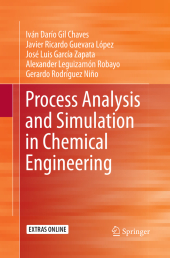 Neuerscheinungen 2019Stand: 2020-02-01 |
Schnellsuche
ISBN/Stichwort/Autor
|
Herderstraße 10
10625 Berlin
Tel.: 030 315 714 16
Fax 030 315 714 14
info@buchspektrum.de |

José Luis García Zapata, Iván Darío Gil Chaves, Javier Ricardo Guevara López
(Beteiligte)
Process Analysis and Simulation in Chemical Engineering
Softcover reprint of the original 1st ed. 2016. 2019. xviii, 523 S. 72 SW-Abb., 426 Farbabb., 136 Tabel
Verlag/Jahr: SPRINGER, BERLIN; SPRINGER INTERNATIONAL PUBLISHING 2019
ISBN: 3-319-79201-6 (3319792016)
Neue ISBN: 978-3-319-79201-9 (9783319792019)
Preis und Lieferzeit: Bitte klicken
This book offers a comprehensive coverage of process simulation and flowsheeting, useful for undergraduate students of Chemical Engineering and Process Engineering as theoretical and practical support in Process Design, Process Simulation, Process Engineering, Plant Design, and Process Control courses. The main concepts related to process simulation and application tools are presented and discussed in the framework of typical problems found in engineering design. The topics presented in the chapters are organized in an inductive way, starting from the more simplistic simulations up to some complex problems.
Preface Chapter 1 Process Simulation in Chemical Engineering 1.1. Introduction 1.2. Chemical process simulators 1.3. Types of process simulators 1.3.1. Simultaneous or Equation oriented simulators 1.3.2. Hybrid simulators 1.3.3. Aspen Plus© and Aspen Hysys© 1.4. Applications of process simulation 1.4.1. Computer-aided design 1.4.2. Process optimization 1.4.3. Solution of operating problems 1.4.4. Other applications 1.5. Convergence Analysis 1.5.1. Convergence Methods (Babu, 2004 ; Dimian, 2003 ; Seider, Seader & Lewin, 2004) 1.5.2. Problems with simple recycles 1.5.3. Partitioning and topological analysis 1.5.4. Nested recycles 1.6. Introductory example 1.6.1. Problem description 1.6.2. Simulation using Aspen HYSYS© 1.6.3. Simulation using Aspen Plus© 1.7. Sensitivity Analysis 1.7.1. Sensitivity Analysis in Aspen Plus© 1.7.2. Sensitivity Analysis in Aspen HYSYS© 1.8. Design specifications 1.9. Summary 1.10. Problems Chapter 2 Thermodynamic and property models 2.1. Introduction 2.2. Ideal model 2.3. Equations of State 2.4. Activity coefficient models 2.5. Special Models 2.5.1. Polymeric systems 2.5.2. Electrolytic System 2.6. Integration of the activity models with equations of the state 2.7. Selection of thermodynamic model 2.8. Example of property model selection 2.9. Example of phase diagram 2.10. Example of parameter adjustment 2.11. Hypothetical components 2.11.1. Usage in Aspen HYSYS© 2.11.2. Usage in Aspen Plus© 2.12. Summary 2.13. Problems Chapter 3 Fluid Handling Equipment 3.1 Introduction 3.2 General Aspects 3.2.1 Background 3.2.2 Piping 3.2.3 Pumps 3.2.4 Compressors and Expanders 3.3 Modules available in Aspen Plus© 3.4 Modules available in Aspen HYSYS© 3.5 Gas Handling Introductory Example 3.5.1 Problem Description 3.5.2 Simulation in Aspen HYSYS© 3.5.3 Results Analysis 3.6 Liquid Handling Introductory Example 3.6.1 Problem Description 3.6.2 Process Simulation 3.6.3 Results Analysis 3.7 Summary 3.8 Problems Chapter 4 Heat Exchange Equipment and Heat Integration 4.1 Introduction 4.2 Types of Programs Available 4.3 General Aspects 4.3.1 Shortcut Calculation (Holman, 1999) 4.3.2 Rigorous Calculation (Holman, 1999) 4.3.3 Calculation models 4.4 Modules available in Aspen Plus© 4.5 Modules available in Aspen HYSYS© 4.5.1 Thermodynamic Heat Exchangers 4.6 Introductory Example 4.6.1 Problem Description 4.6.2 Simulation in Aspen Plus© 4.6.3 Simulation in Aspen HYSYS© 4.6.4 Simulation in Aspen HTFS© 4.6.5 Results Analysis 4.7 Process Heat Integration 4.7.1 Introduction 4.7.2 Theoretical principles 4.7.3 Aspen Energy Analyzer 4.8 Summary 4.9 Problems Chapter 5 Chemical reactors 5.1 Introduction 5.2 General Aspects 5.3. Equations for Reactor Design 5.4. Modules Available in Aspen Plus© 5.5. Available modules in ASPEN HYSYS© 5.6. Introductory example of Reactors 5.6.1. Problem Description 5.6.2. Simulation in Aspen Hysys© 5.6.3. Results Analysis 5.7. Propylene Glycol Reactor Example 5.7.1. General Aspects 5.7.2. Process Simulation in Aspen Plus© 5.7.3. Results Analysis 5.8. Methanol Reforming Reactor 5.8.1. Problem Description 5.8.2. Simulation in Aspen Plus© 5.8.3. Simulation in Aspen Hysys© 5.8.4. Analysis And Results Comparison 5.9. Summary 5.10. Problems Chapter 6 Gas-Liquid Separation Operations 6.1 Introduction 6.2 Available modules in Aspen Plus© 6.2.1 Shortcut Methods 6.2.2 Rigorous Methods 6.3 Modules available in Aspen Hysys© 6.3.1 Predefined Columns 6.3.2 Shortcut Calculation Model 6.3.3 Column Interface 6.4 Distillation Introductory Example 6.4.1 Problem Description 6.4.2 Simulation In Aspen Plus© 6.4.3 Simulation in Aspen Hysys© 6.4.4 Results Analysis and Comparison 6.5 Absorption Introductory Example 6.5.1 Problem Description 6.5.2 Process Simulation 6.6 Enhanced Distillation 6.6.1 Residue Curves Map (RCM) 6.6.2 Extractive Distillation 6.7 Non-Equilibrium Models 6.7.1 Non-Equilibrium Model Example 6.8 Columns Thermal And Hydraulic Analysis 6.8.1 Application Exercise 6.9 Summary 6.10 Proble


